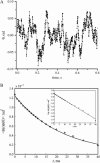Fluctuation analysis of Caulobacter crescentus adhesion
- PMID: 16361338
- PMCID: PMC1386799
- DOI: 10.1529/biophysj.105.064592
Fluctuation analysis of Caulobacter crescentus adhesion
Abstract
The aquatic bacterium Caulobacter crescentus divides asymmetrically to a flagellated swarmer cell and a cell with a stalk. At the end of the stalk is an adhesive organelle known as the holdfast, which the stalked cell uses to attach to a solid surface. Often there are two or more cells with their stalks attached to the same holdfast. By analyzing the fluctuations in the stalk angle for a pair of cells attached to a single holdfast, we determine the elastic stiffness of the holdfast. We model the holdfast as three torsional springs in series and find that the effective torsional spring constant for the holdfast is of the order of (10(-17)-10(-18)) Nm, with unequal spring constants. The asymmetry suggests the sequence in which the cells attach to each other, and in some cases suggests that strong crosslinks form between the stalks as they make a shared holdfast.
Figures










References
-
- Kurtz, H. D., and J. Smith. 1994. The Caulobacter crescentus holdfast: identification of holdfast attachment complex genes. FEMS Microbiol. Lett. 116:175–182. - PubMed
-
- Brun, Y. V., and R. Janakiraman. 2000. Dimorphic life cycles of Caulobacter and stalked bacteria. In Prokaryotic Development. Y.V. Brun and L. Shimkets, editors. ASM Press, Washington, DC. 297–317.
Publication types
MeSH terms
LinkOut - more resources
Full Text Sources

